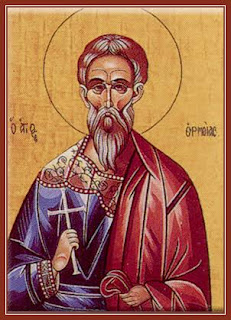Saint of the Day † (May 31) ✠ St. Hermias of Comana
† Saint of the Day †
(May 31)
✠ St. Hermias of Comana ✠
Martyr:
Born: ----
Died: 160 AD
Comana, Cappadocia
Venerated in:
Roman Catholic Church
Eastern Orthodox Church
Canonized: Pre-congregation
Feast: May 31
Hermias of Comana is an early martyr commemorated in the Orthodox Church and the Catholic Church. He lived in the 2nd century and was a soldier in the Roman army until he confessed Christ and was tortured. His feast day is 31 May.
Hermias, the holy martyr, made his mark during the years of Antoninus Pius (138-161) and Marcus Aurelius (161-180). Hermias had served as a soldier for many years until he was elderly and white-haired. He was comely not only in the flesh but also in the spirit as he put away worldly things. While in the city of Comana of Cappadocia, he was arrested upon professing Jesus and upholding his belief in the Christian Faith. Hermias was brought before Governor Sebastian. Since the old soldier laid aside earthly soldiery, he refused to offer sacrifice to the idols. With his denial of the pagan gods of perdition, the application of harsh tortures was the penalty for the soldier of Christ.
The first punishment involved the breaking of his jaw upon a face that was generally deemed fair. Close upon this brutal act, they flayed his facial flesh. This was followed by the uprooting of his teeth. Afterwards, they lit a furnace into which the saint was cast. He was bedewed with the grace of the Spirit so that, after three days, the gallant martyr was still standing in the flames until he exited unharmed. Next, they contrived to put him to death by having him drink a deadly potion. The concoction was mixed by a magician, named Marus. The saint partook of the poisonous draft and suffered no ill effects. A second drink, more toxic, was prepared. This also failed to kill Hermias. In the sequel, he not only survived the noxious goblet but also drew to the Faith of Christ the very magician who formulated the lethal mixture. The magician also publicly confessed Jesus Christ, for which declaration he was swiftly beheaded. In this manner, he received the crown of martyrdom.
As for Hermias, he was to suffer subsequent torments. He endured all the vehement pain and rending of his body as though someone else was suffering. With the use of rakes and combs, they severed and shivered his sinews and muscles. After a while, a cauldron of boiling oil was prepared. The martyr was thrown into that bubbling unction, but he emerged unscathed. From that moment, they began the operation of plucking out his eyes. During the gouging, he spoke calmly to Sebastian and said, “Thou mayest take the eyes of the flesh that used to look upon this world’s vanity. But the eyes of my heart remain, clearly fixed upon the true light.”
As if this excruciating torture were not enough, there ensued another punishment: he was suspended upside down for three days. In this position, too, the martyr triumphed as he fixed his mind’s eye heavenward upon God. When men were sent to confirm whether Hermias had survived his wounds and haemorrhaging, they were blinded from terror at seeing him alive. The blind appealed to the martyr for help. He invited them to approach and then healed them in the name of our Savior. Since he continued to refuse worship to the pagan deities, the idolaters could no longer bear his heroic exploits and wonders. The governor, losing command of himself, with his own sword, dispatched Hermias to the next life. The honourable head of Christ’s warrior, Hermias, was severed but crowned in the heavens. Christians secured his relics and gave him an honourable burial. His relics were known to work wonders.




Comments
Post a Comment